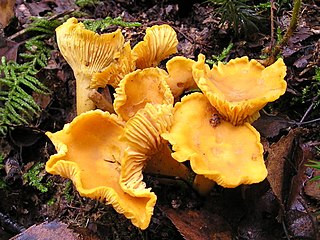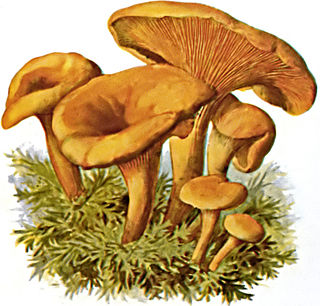
The Cantharellaceae are a family of fungi in the order Cantharellales. The family contains the chanterelles and related species, a group of fungi that superficially resemble agarics but have smooth, wrinkled, or gill-like hymenophores. Species in the family are ectomycorrhizal, forming a mutually beneficial relationship with the roots of trees and other plants. Many of the Cantharellaceae, including the chanterelle, the Pacific golden chanterelle, the horn of plenty, and the trumpet chanterelle, are not only edible, but are collected and marketed internationally on a commercial scale.

The Cantharellales are an order of fungi in the class Agaricomycetes. The order includes not only the chanterelles (Cantharellaceae), but also some of the tooth fungi (Hydnaceae), clavarioid fungi, and corticioid fungi (Botryobasidiaceae). Species within the order are variously ectomycorrhizal, saprotrophic, associated with orchids, or facultative plant pathogens. Those of economic importance include edible and commercially collected Cantharellus, Craterellus, and Hydnum species as well as crop pathogens in the genera Ceratobasidium and Thanatephorus/Rhizoctonia.

The Clavulinaceae are a family of fungi in the order Cantharellales. The family is not well defined, but currently comprises species of clavarioid fungi as well as some corticioid fungi. These species are nutritionally diverse, some being ectomycorrhizal, others wood-rotting saprotrophs, others lichenized, and yet others lichenicolous.

The Hygrophoropsidaceae are a family of mushrooms that are gilled in appearance but lie within the Boletales. The family contains 18 species within two genera: Leucogyrophana and Hygrophoropsis, with the best-known member being the "false chanterelle", Hygrophoropsis aurantiaca. Hygrophoropsidaceae was circumscribed by French mycologist Robert Kühner in 1980, with Hygrophoropsis as the type genus. Unlike most members of the Boletales, Hygrophoropsidaceae species are saprophytic wood-rotting fungi that cause brown rot in their hosts. The genera Austropaxillus and Tapinella, once placed in this family, are now classified in the Serpulaceae and Tapinellaceae, respectively.

The Hydnaceae are a family of fungi in the order Cantharellales. Originally the family encompassed all species of fungi that produced basidiocarps having a hymenium consisting of slender, downward-hanging tapering extensions referred to as "spines" or "teeth", whether they were related or not. This artificial but often useful grouping is now more generally called the hydnoid or tooth fungi. In the strict, modern sense, the Hydnaceae are limited to the genus Hydnum and related genera, with basidiocarps having a toothed or poroid hymenium. Species in the family are ectomycorrhizal, forming a mutually beneficial relationship with the roots of trees and other plants. Hydnum repandum is an edible species, commercially collected in some countries and often marketed under the French name pied de mouton.

The Botryobasidiaceae are a family of fungi in the order Cantharellales. The family contains a group of corticioid fungi that form thin, web-like basidiocarps. Some species form asexual anamorphs producing chlamydospores. All are believed to be wood-rotting or litter-rotting saprotrophs. None is known to be of any economic importance.

The Bankeraceae are a family of fungi in the order Thelephorales. Taxa are terrestrial, and ectomycorrhizal with plant species in families such as Pinaceae or Fagaceae. The family was circumscribed by Marinus Anton Donk in 1961. According to a 2008 estimate, the family contains 6 genera and 98 species.

Geoglossaceae is a family of fungi in the order Geoglossales, class Geoglossomycetes. These fungi are broadly known as earth tongues. The ascocarps of most species in the family Geoglossaceae are terrestrial and are generally small, dark in color, and club-shaped with a height of 2–8 cm. The ascospores are typically light-brown to dark-brown and are often multiseptate. Other species of fungi have been known to parasitize ascocarps. The use of a compound microscope is needed for accurate identification.

The Physalacriaceae are a family of fungi in the order Agaricales. Species in the family have a widespread distribution, ranging from the Arctic, (Rhizomarasmius), to the tropics, e.g. Gloiocephala, and from marine sites (Mycaureola) and fresh waters (Gloiocephala) to semiarid forests (Xerula).

The Sarcoscyphaceae are a family of cup fungi in the order Pezizales. Members of the Sarcoscyphaceae are cosmopolitan in distribution, found in both tropical and temperate regions.

The Mycenaceae are a family of fungi in the order Agaricales. According to the Dictionary of the Fungi, the family contains 10 genera and 705 species. This is one of several families that were separated from the Tricholomataceae as a result of phylogenetic analyses. Taxa in the Mycenaceae are saprobic, have a cosmopolitan distribution, and are found in almost all ecological zones. The family was circumscribed by Caspar van Overeem in 1926.
The Acaulosporaceae are a family of fungi in the order Diversisporales. Species in this family are widespread in distribution, and form arbuscular mycorrhiza and vesicles in roots. The family contains two genera and 31 species.

Lentaria is a genus of fungi in the family Lentariaceae. The genus has a widespread distribution and contains 17 species. It was circumscribed by British mycologist Edred John Henry Corner in 1950.

Physalacria is a genus of fungi in the family Physalacriaceae. The genus contains 30 species widely distributed in tropical regions of the Southern Hemisphere.
Pseudotyphula is a genus of fungus in the family Marasmiaceae. The genus is monotypic, containing the single species Pseudotyphula ochracea, found in North America. The genus was circumscribed by British mycologist E.J.H. Corner in 1953.
Allantula is a fungal genus in the family Pterulaceae. The genus is monotypic, containing the singles species Allantula diffusa, found in Brazil. The genus and species were described by British mycologist E.J.H. Corner in 1952.

The Clavariadelphaceae are a family of fungi belonging in what is classically known as the Gomphales order, or cladistically as the gomphoid-phalloid clade. First described by British botanist E.J.H. Corner in 1970, the family has 2 genera and 26 species.

The Tulasnellaceae are a family of fungi in the order Cantharellales. The family comprises mainly effused (patch-forming) fungi formerly referred to the "jelly fungi" or heterobasidiomycetes. Species are wood- or litter-rotting saprotrophs, but many are also endomycorrhizal associates of orchids and some have also been thought to form ectomycorrhizal associations with trees and other plants.
Neopaxillus is a genus of fungi in the family Crepidotaceae. According to the Dictionary of the Fungi, the family contains five species found in Central and South America; a sixth, N. dominicanus, was reported in 2011. It was formerly considered to belong in the family Serpulaceae in the order Boletales, but molecular analysis showed that Neopaxillus is better placed in the Agaricales as a sister group to Crepidotus.

Clavulicium is a genus of corticioid fungi in the family Stereopsidaceae. It was formerly placed in the family Clavulinaceae in the order Cantharellales but was found to belong in a new order along with Stereopsis in 2014. The widespread genus was circumscribed by the French mycologist Jacques Boidin in 1957. The spores and the basidia of species in the genus are similar to those in Clavulina but also similar to those in Stereopsis. Clavulicium globosum is now a species of Stereopsis.
















